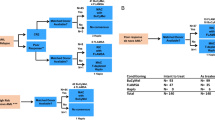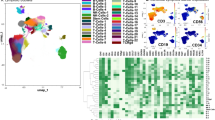Abstract
During the past decade it has become apparent that patients can be transplanted successfully after preparation with regimens of reduced intensity. Reduced intensity preparations have resulted in lower morbidity and mortality during the pre-engraftment period, but have not reduced later occurring infections, GVHD and relapse. Outcome-determining risk factors that characterize patients at diagnosis as well as during their course include age, cytogenetic configuration, hematopoietic elements and a previous history of myelodysplasia or cytoreductive therapy for a pre-existing malignancy. These factors are complemented by the response to induction therapy and subsequent treatments as well as by the duration of the response. More recently, gene expression profiling of leukemic cells has added a new dimension to simultaneously assessed biological risk factors that may ultimately lead to individuation of therapy.
This is a preview of subscription content, access via your institution
Access options
Subscribe to this journal
Receive 12 print issues and online access
$259.00 per year
only $21.58 per issue
Buy this article
- Purchase on Springer Link
- Instant access to full article PDF
Prices may be subject to local taxes which are calculated during checkout
Similar content being viewed by others
References
Thomas ED, Buckner CD, Clift RA, Fefer A, Johnson FL, Neiman PE et al. Marrow transplantation for acute nonlymphoblastic leukemia. NEJM 1979; 301: 507–508.
Sandmaier BM, Mackinnon S, Richard W, Childs RW . Reduced intensity conditioning for allogeneic hematopoietic cell transplantation: current perspectives. Biol Blood Marrow Transplant 2007; 13: 87–97.
Heuser M, Wingen LU, Steinemann D, Cario G, von Neuhoff N, Tauscher M et al. Gene-expression profiles and their association with drug resistance in adult acute myeloid leukemia. Haematologica 2005; 90: 1484–1492.
Grimwade D, Walker H, Oliver F, Wheatley K, Harrison C, Harrison G et al. The importance of diagnostic cytogenetics on outcome in AML: analyses of 1612 patients entered into the MRC AML 10 trial. Blood 1998; 92: 2322–2333.
Slovak ML, Kopecky KJ, Cassileth PA, Harrington DH, Theil KS, Mohamed A et al. Karyotypic analysis predicts outcome of preremission and postremission therapy in adult acute myeloid leukemia: a Southwest Oncology Group/Eastern Coopearative Oncology Group Study. Blood 2000; 96: 4075–4083.
Schoch C, Kern W, Schnittger S, Buchner T, Hiddemann W, Haferlach T . The influence of age on prognosis of de novo acute myeloid leukemia differs according to cytogenetic subgroups. Haematologica 2004; 89: 1082–1090.
Baldus CD, Mrozek K, Marcucci G, Bloomfield CD . Clinical outcome of de novo acute myeloid leukaemia patients with normal cytogenetics is affected by molecular genetic alterations: a concise report. Br J Haematol 2007; 137: 387–400.
Marucci G, Maharry K, Whitman SP, Vukosavljevic T, Paschka P, Langer C et al. High expression levels of the ETS-related gene, ERG, predict adverse outcome and improve molecular risk based classification of cytogenetically normal acute myeloid leukemia: a Cancer and Leukemia Group B study. J Clin Oncol 2007; 25: 3337–3343.
Mead AJ, Linch DC, Hills RK, Wheatley K, Burnett AK, Gale RE . FLT3 tyrosine kinase domain mutations are biologically distinct from and have a significantly more favorable prognosis than FLT3 internal tandem duplications in patients with acute myeloid leukemia. Blood 2007; 110: 1262–1270.
Gale RP, Horowitz MM, Weiner RS, Ash RC, Atkinson K, Babu R et al. Impact of cytogenetic abnormalities on outcome of bone marrow transplants in acute myelogenous leukemia in first remission. Bone Marrow Transplant 1995; 16: 203–208.
Ferrant A, Labopin M, Frassoni F, Prentice HG, Cahn JY, Blaise D et al. Karyotype in acute myeloblastic leukemia: prognostic significance for Bone Marrow Transplantation in first remission: a European Group for Blood and Marrow Transplantation Study. Blood 1997; 90: 2931–2938.
Fung HC, Stein A, Slovak ML, O'Donnell MR, Snyder DS, Cohen S et al. A long-term follow-up report on allogeneic stem cell transplantation for patients with primary refractory acute myelogenous leukemia: impact of cytogenetic characteristics on transplantation outcome. Biol Blood Marrow Transplant 2003; 9: 766–771.
Armand P, Kim HT, DeAngelo DJ, Ho VT, Cutler CS, Stone RM et al. Impact of cytogenetics on outcome of de novo and therapy-related AML and MDS after allogeneic transplantation. Biol Blood Marrow Transplant 2007; 13: 655–664.
Chalandon Y, Barnett MJ, Horsman DE, Conneally EA, Nantel SH, Nevill TJ et al. Influence of cytogenetic abnormalities on outcome after allogeneic bone marrow transplantation for acute myeloid leukemia in first complete remission. Biol Blood Marrow Transplant 2002; 8: 435–443.
Tallman MS, Dewald GW, Gandham S, Logan BR, Keating A, Lazarus HM et al. Impact of cytogenetics on outcome of matched unrelated donor hematopoietic stem cell transplantation for acute myeloid leukemia in first or second complete remission. Blood 2007; 110: 409–417.
Suciu S, Mandelli F, de Witte T, Zittoun R, Gallo E, Labar B et al. Allogeneic compared with autologous stem cell transplantation in the treatment of complete remission (CR1): an intention-to-treat analysis of the EORTC/GIMEMAAML-10 trail. Blood 2003; 102: 1232–1240.
Yanada M, Matsuo K, Emi N, Naoe T . Efficacy of allogeneic hematopoietic stem cell transplantation depends on cytogenetic risk for acute myeloid leukemia in first disease remission: a meta analysis. Cancer 2005; 103: 1652–1658.
Cook G, Clark RE, Crawley C, Mackinnon S, Russell N, Thomson K et al. The outcome of sibling and unrelated donor allogeneic stem cell transplantation in adult patients with acute myeloid leukemia in first remission who were initially refractory to first induction chemotherapy. Biol Blood Marrow Transplant 2006; 12: 293–300.
Johny A, Song KW, Nantel SH, Lavoie JC, Toze CL, Hogge DE et al. Early stem cell transplantation for refractory acute leukemia after salvage therapy with high-dose Etoposide and Cyclophosphamide. Biol Blood Marrow Transplant 2006; 12: 480–489.
Breems DA, van Putten WL, Huijgens PC, Ossenkoppele GJ, Verhoef GE, Verdonk LF et al. Prognostic index for adult patients with acute myeloid leukemia in first relapse. J Clin Oncol 2005; 23: 1969–1978.
Bertz H, Potthoff K, Finke J . Allogeneic stem-cell transplantation from related and unrelated donors in older patients with myeloid leukemia. J Clin Oncol 2003; 21: 1480–1484.
Spyridonidis A, Bertz H, Ihorts G, Grüllich C, Finke J . Hematopoietic cell transplantation from unrelated donors as an effective therapy for older patients (⩾60 years) with active myeloid malignancies. Blood 2005; 105: 4147–4148.
Krauter J, Heil G, Hoelzer D, Ottmann O, Martin H, Lübbert M et al. Role of consolidation therapy in the treatment of patients up to 60 years with high risk AML. Blood 2005; 106: 172 (abstract).
Kahl C, Storer BE, Sandmaier BM, Mielcarek M, Maris MB, Blume KG et al. Relapse risk in patients with malignant diseases given allogeneic hematopoietic cell transplantation after nonmyeloablative conditioning. Blood 2007; 110: 2744–2748.
Russell JA, Savoie ML, Balogh A, Turner AR, Larratt L, Chaudhry MA et al. Allogeneic transplantation for adult acute leukemia in first and second remission with a novel regimen incorporating daily intravenous Busulfan and Thymoglobulin. Biol Blood Marrow Transplant 2007; 13: 814–821.
Oran B, Giralt S, Couriel D, Hosing C, Shpall EJ, de Meis E et al. Treatment of AML and MDS relapsing after reduced-intensity conditioning and allogeneic hematopoietic stem cell transplantation. Leukemia 2007; 21: 2540–2544.
Schmid C, Labopin M, Nagler A, Bomhauser M, Finke J, Fassas A et al. Donor lymphocyte infusion in the treatment of first hematological relapse after allogeneic stem-cell transplantation in adults with acute myeloid leukemia: a retrospective risk factors analysis and comparison with other strategies by the EBMT Acute Leukemia Working Party. J Clin Oncol 2007; 31: 4938–4945.
Author information
Authors and Affiliations
Corresponding author
Rights and permissions
About this article
Cite this article
Messner, H. Current status of blood and marrow transplantation for patients with AML. Bone Marrow Transplant 42 (Suppl 1), S14–S17 (2008). https://doi.org/10.1038/bmt.2008.106
Published:
Issue Date:
DOI: https://doi.org/10.1038/bmt.2008.106
Keywords
This article is cited by
-
Early allo-SCT for AML with a complex aberrant karyotype—results from a prospective pilot study
Bone Marrow Transplantation (2012)



